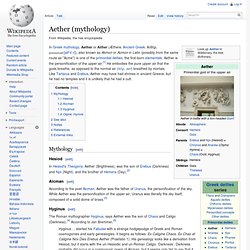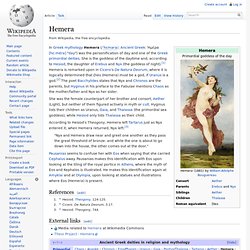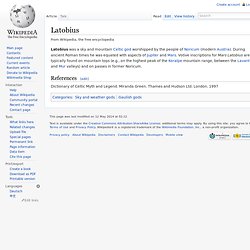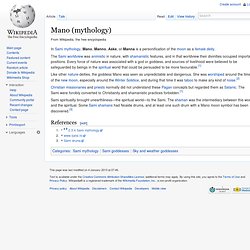

Aether (mythology) In Greek mythology, Aether or Aither (Æthere, Ancient Greek: Αἰθήρ, pronounced [aitʰɛ̌ːr]), also known as Akmon or Acmon in Latin (possibly from the same route as "Acme") is one of the primordial deities, the first-born elementals.

Aether is the personification of the upper air.[1] He embodies the pure upper air that the gods breathe, as opposed to the normal air (ἀήρ, aer) breathed by mortals. Like Tartarus and Erebus, Aether may have had shrines in ancient Greece, but he had no temples and it is unlikely that he had a cult. Hyginus ... started his Fabulae with a strange hodgepodge of Greek and Roman cosmogonies and early genealogies. It begins as follows: Ex Caligine Chaos. Ex Chao et Caligine Nox Dies Erebus Aether (Praefatio 1). Aide (deity) Caelus. Hemera. According to Hesiod's Theogony, Hemera left Tartarus just as Nyx entered it; when Hemera returned, Nyx left:[3] "Nyx and Hemera draw near and greet one another as they pass the great threshold of bronze: and while the one is about to go down into the house, the other comes out at the door.

" References[edit] External links[edit] Horagalles. Sami people worshipping Horagalles or Tiermes.

Copper engraving by Bernard Picart from Cérémonies et coutumes religieuses de tous les peuples du monde (1723–43) In Sami shamanism, Horagalles, also written Hora Galles and Thora Galles and often equated with Tiermes or Aijeke (i.e. "grandfather or great grandfather"), is the thunder god. He is depicted as a wooden figure with a nail in the head and with a hammer, or occasionally on shaman drums, two hammers.
His name is derived from that of the Norse god Thor. Ilmatar. In the Kalevala, the Finnish national epic, Ilmatar was a virgin spirit of the air.[1] Origins[edit] The name Ilmatar is derived from the Finnish word ilma, meaning "air," and the suffix -tar, denoting a female spirit.

Thus, her name literally means "female air spirit. " In the Kalevala she was also occasionally called Luonnotar, which means "female spirit of nature" (Finnish luonto, "nature").[2] She was impregnated by the sea and wind and thus became the mother of Väinämöinen. Homage[edit] Sibelius's Luonnotar[edit] Iris (mythology) In Greek mythology, Iris (/ˈɨrɨs/; Ἶρις) is the personification of the rainbow and messenger of the gods.

She is also known as one of the goddesses of the sea and the sky. Iris links the gods to humanity. Jupiter (mythology) The consuls swore their oath of office in Jupiter's name, and honoured him on the annual feriae of the Capitol in September.

To thank him for his help (and to secure his continued support), they offered him a white ox (bos mas) with gilded horns.[10] A similar offering was made by triumphal generals, who surrendered the tokens of their victory at the feet of Jupiter's statue in the Capitol. Latobius. Dictionary of Celtic Myth and Legend.

Miranda Green. Thames and Hudson Ltd. London. 1997. Máni. Attestations[edit] Poetic Edda[edit]

Mano (mythology) In Sami mythology, Mano, Manno, Aske, or Manna is a personification of the moon as a female deity.

The Sami worldview was animistic in nature, with shamanistic features, and in that worldview their divinities occupied important positions. Every force of nature was associated with a god or goddess, and sources of livelihood were believed to be safeguarded by beings in the spiritual world that could be persuaded to be more favourable.[1] Like other nature-deities, the goddess Mano was seen as unpredictable and dangerous. Perkele. Pronunciation.

Sabazios. Bronze hand used in the worship of Sabazios (British Museum). Roman 1st-2nd century CE. Hands decorated with religious symbols were designed to stand in sanctuaries or, like this one, were attached to poles for processional use. Sabazios (Ancient Greek: Σαβάζιος) is the nomadic horseman and sky father god of the Phrygians and Thracians. In Indo-European languages, such as Phrygian, the -zios element in his name derives from dyeus, the common precursor of Latin deus ('god') and Greek Zeus. Though the Greeks interpreted Phrygian Sabazios[1] with both Zeus and Dionysus,[2] representations of him, even into Roman times, show him always on horseback, as a nomadic horseman god, wielding his characteristic staff of power. Thracian/Phrygian Sabazios[edit] Possible early conflict between Sabazios and his followers and the indigenous mother goddess of Phrygia (Cybele) may be reflected in Homer's brief reference to the youthful feats of Priam, who aided the Phrygians in their battles with Amazons.
Sól (sun) Sól (Old Norse "Sun")[1] or Sunna (Old High German, and existing as an Old Norse and Icelandic synonym: see Wiktionary sunna, "Sun") is the Sun personified in Germanic mythology. Stribog. Stribog (Stribozh, Strzybóg, Стрибог) in the Slavic pantheon, is the god and spirit of the winds, sky and air; he is said to be the ancestor (grandfather) of the winds of the eight directions.
The etymology of the name is disputed, see here (russian only). The names of some lakes, rivers and villages on Russian and Polish lands are derived from Stribog or Strzybóg cf. the village Strzyboga near Skierniewice in Poland. Some consider this evidence of Stribog worship in those areas. Taranis. Gundestrup cauldron, created between 200 BC and 300 AD, is thought to have a depiction of Taranis on the inner wall of cauldron on tile C The name as recorded by Lucan is unattested epigraphically, but variants of the name include the forms Tanarus, Taranucno-, Taranuo-, and Taraino-.[3][4] The name is continued in Irish as Tuireann, and is likely connected with those of Germanic (Norse Thor, Anglo-Saxon Þunor, German Donar) and Sami (Horagalles) gods of thunder.
Taranis is likely associated with the Gallic Ambisagrus (likely from Proto-Celtic *ambi-sagros = "about-strength"), and in the interpretatio romana with Jupiter. Etymology[edit] Taranis, as a personification of thunder, is often identified with similar deities found in other Indo-European pantheons. Of these, Old Norse Þórr, Anglo-Saxon Þunor, Old High German Donar—all from Proto-Germanic *þunraz or *þonar-oz—and the Hittite theonym Tarhun (see Teshub) contain a comparable *torun- element.
Tempestas. In ancient Roman religion, Tempestas (Latin tempestas: "season, weather; bad weather; storm, tempest") is a goddess of storms or sudden weather. Thor. Tinia. Some of Tinia's defining epithets are detailed on the Piacenza Liver, a bronze model of a liver used for haruspicy. Some of his epithets inscribed there include Tin Cilens, Tin Θuf and Tinś Θne. Triglav (mythology) Triglav (Bosnian, Croatian, Slovenian and Serbian Latin: Triglav; Ukrainian, Russian, Macedonian, Bulgarian and Serbian Cyrillic: Триглав; Czech and Slovak: Trihlav; Polish: Trygław, Trzygłów; Belarusian:Трыглаў) (meaning 'three headed') also sometimes called troglav is a deity in Slavic mythology.
Triglav is depicted as a three-headed man sometimes with bands of (gold) blindfolds over his eyes, or a man with three goat heads. Several temples dedicated to Triglav existed near present-day Szczecin, Poland. Týr. Týr (/ˈtɪər/;[1] Old Norse: Týr [tyːr]) is a god associated with law and heroic glory in Norse mythology, portrayed as one-handed. Corresponding names in other Germanic languages are Gothic Teiws, Old English Tīw and Old High German Ziu and Cyo, all from Proto-Germanic *Tīwaz. Ukko. Pre-Christian pendants associated with gods of thunder.
A) "Finnish type", B) "Swedish type", C) "Wolf's cross". Uranus (mythology) Zeus. Name.